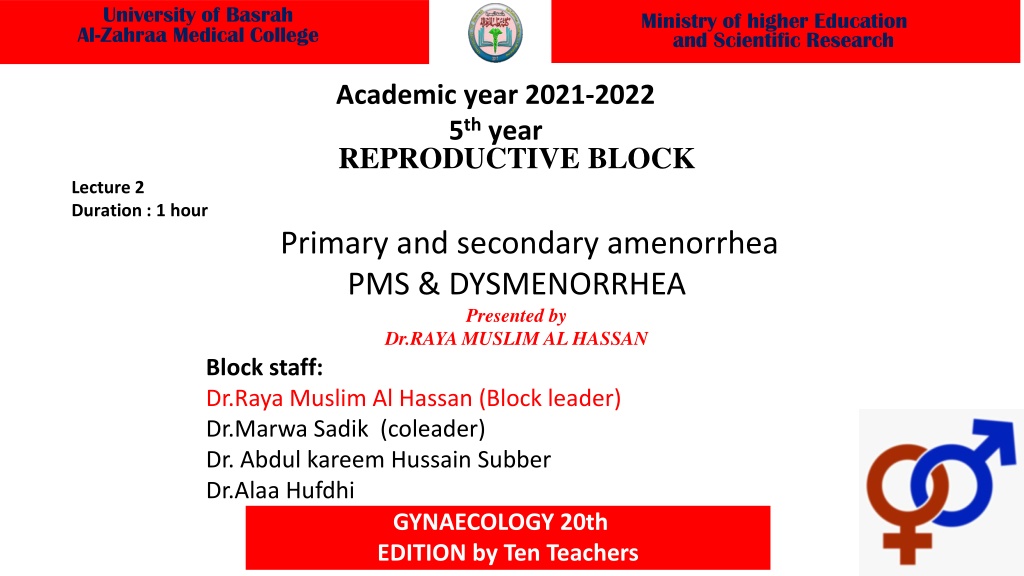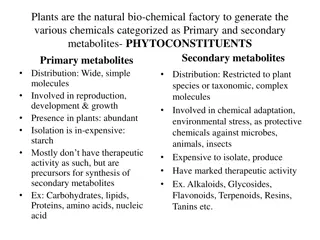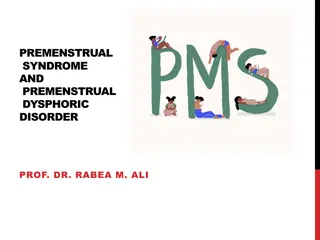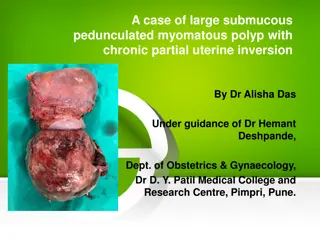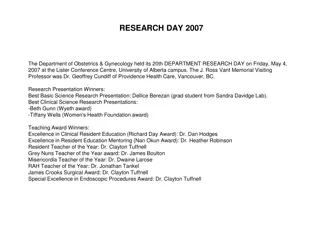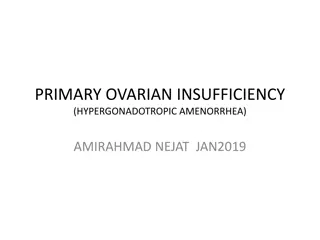Understanding Primary and Secondary Amenorrhea, PMS, and Dysmenorrhea in Gynecology
Explore the concepts of primary and secondary amenorrhea, PMS, and dysmenorrhea in gynecology through detailed lectures and learning objectives at the University of Basrah Al-Zahraa Medical College. Topics include differentiating between primary and secondary amenorrhea, management strategies, causes, and treatments of dysmenorrhea and PMS. Dive into the various origins and causes of amenorrhea, including hypothalamic/pituitary, ovarian, and outflow tract issues.
Download Presentation

Please find below an Image/Link to download the presentation.
The content on the website is provided AS IS for your information and personal use only. It may not be sold, licensed, or shared on other websites without obtaining consent from the author. Download presentation by click this link. If you encounter any issues during the download, it is possible that the publisher has removed the file from their server.
E N D
Presentation Transcript
University of Basrah Al-Zahraa Medical College Ministry of higher Education and Scientific Research Academic year 2021-2022 5th year REPRODUCTIVE BLOCK Lecture 2 Duration : 1 hour Primary and secondary amenorrhea PMS & DYSMENORRHEA Presented by Dr.RAYA MUSLIM AL HASSAN Block staff: Dr.Raya Muslim Al Hassan (Block leader) Dr.Marwa Sadik (coleader) Dr. Abdul kareem Hussain Subber Dr.Alaa Hufdhi GYNAECOLOGY 20th EDITION by Ten Teachers
University of Basrah Al-Zahraa Medical College Ministry of higher Education and Scientific Research Learning objectives Learning objectives Discriminate between primary and secondary amenorrhoea To be familiar with the management of amenorrhea Define dysmenorrhea/identify its causes and treatment To understand PMS,its causes and treatment
University of Basrah Al-Zahraa Medical College Ministry of higher Education and Scientific Research Primary Amenorrhoea Never had a period. Absence of menses by age 14 with absence of Secondary Sexual Characteristics (SSC) e.g. breast development or absence by age 16 with normal SSC Secondary Amenorrhoea Established menstruation has ceased. Cessation of menstruation for 6 consecutive months in a women who has previously had regular periods, that is not due to pregnancy, lactation or menopause.
University of Basrah Al-Zahraa Medical College Ministry of higher Education and Scientific Research Causes of amenorrhea Origin is Hypothalamic/Pituitary, Ovarian or Outflow tract (uterus, vagina, cervix)
University of Basrah Al-Zahraa Medical College Ministry of higher Education and Scientific Research 1. Hypothalamic/Pituitary Amenorrhoea Inadequate levels of FSH lead to inadequately stimulated ovaries, which then fail to produce enough oestrogen to stimulate the endometrium of the uterus, giving amenorrhoea. In general, women with hypogonadotropic amenorrhoea are potentially fertile. Primary Hypothalamic Amenorrhoea * Constitutional delay: exclude other causes. Constitutional delay No anatomical anomaly &the endocrine investigations are normal , but there is immature pulsatile release of GnRh Those girls will eventually menstruate spontaneously as the maturation process proceeds *Kallmann Syndrome Inability to produce GnRH ( LH & FSH subsequently)
University of Basrah Al-Zahraa Medical College Ministry of higher Education and Scientific Research Secondary Hypothalamic Amenorrhoea * Exercise or stress-related amenorrhoea * Eating disorders and weight loss ( anorexia or bulimia). Fall below the critical weight of 47kg menses will cease * CNS neoplasm, trauma or infilterating disease such as TB or sarcoidosis . * Drugs affecting HPG axis.
University of Basrah Al-Zahraa Medical College Ministry of higher Education and Scientific Research 2. Secondary Pituitary Amenorrhoea *Sheehan syndrome Hypopituitarism *Hyperprolactinaemia (adenoma) *Haemochromatosis Iron overload Secondary Amenorrhoea may also be caused by hypo/hyperthyroidism or adrenal disease
University of Basrah Al-Zahraa Medical College Ministry of higher Education and Scientific Research 3. Gonadal/End-Organ Amenorrhoea In Ovarian Amenorrhoea the ovary does not respond to pituitary stimulation, giving low oestrogen levels. The lack of ve feedback from oestrogen leads to elevated FSH levels in the menopausal range (Hypergonadotrophic amenorrhoea). Primary Gonadal/End-Organ Gonadal dysgenesis e.g. Turner Syndrome (45, Xo) Androgen Insensitivity Syndrome Receptor abnormalities for FSH and LH Secondary Gonadal/End-Organ premature menopause (ovarian failure) Polycystic Ovarian Syndrome
University of Basrah Al-Zahraa Medical College Ministry of higher Education and Scientific Research 4. Outflow Tract Amenorrhoea In Amenorrhoea of outflow tract origin, the Hypothalamic-Pituitary-Ovarian Axis is functional, therefore FSH level is normal. Primary Outflow Tract Obstruction * Uterine Mullerian agenesis i.e. absent vagina & uterus (Rokitansky syndrome)=15% of primary amenorrhoea * Vaginal Vaginal atresia or transverse septum, imperforate hymen Secondary Outflow Tract Obstruction *Cervical stenosis as in case of conization of the cervix * severe vaginal adhesion following vaginal surgery * uterine causes - Intrauterine Adhesions (Asherman s syndrome) - Endometrial TB
University of Basrah Al-Zahraa Medical College Ministry of higher Education and Scientific Research Imperforated hymen a pubertal girl complain of intermittent abdominal pain which is usually cyclical , the menstrual blood accumulates in the uterus ( Haematometra ) & later on accumulates in the vagina which is distensible organ allow large quantities of blood within it( haematocolpos ), it may be associated with difficulty in defecation & micturition even to the extent of urine retention . Examination : abdominal mass & observation of the introits will reveal tense bulging membrane which is the hymen Treatment : simple exicion
University of Basrah Al-Zahraa Medical College Ministry of higher Education and Scientific Research Ashermann syndrome this is a condition in which intrauteine adhesions prevent normal growth of endometrium this may be the result of a too vigrous endometrial curettage affecting the basalis layer of the endometrium or adhesions may follow an episode of endometritis ,intrauterine adhesions may be seen on HSG or hysteroscopy .
University of Basrah Al-Zahraa Medical College Ministry of higher Education and Scientific Research management History Examination/secondary sexual characters Investigations: 1. hormonal study FSH/LH/S.ESTROGEN 2. ULTRASOUND 3. MRI TREATMENT according to the cause(return back to the causes)
University of Basrah Al-Zahraa Medical College Ministry of higher Education and Scientific Research dysmenorrhea
University of Basrah Al-Zahraa Medical College Ministry of higher Education and Scientific Research
University of Basrah Al-Zahraa Medical College Ministry of higher Education and Scientific Research Dysmenorrhoea is defined as painful menstruation. Types: Primary dysmenorrhea:Primary dysmenorrhoea describes painful periods since onset of menarche and is unlikely to be associated with pathology. secondary dysmenorrhea: describes painful periods that have developed over time and usually have a secondary cause Incidence:45 95% of women
University of Basrah Al-Zahraa Medical College Ministry of higher Education and Scientific Research Aetiology 1.Primary dysmenorrhoea is associated with uterine hypercontractility characterized by excessive amplitude and frequency of contractions and a high resting tone between contractions. 2. During contractions endometrial blood flow is reduced and there seems to be a good correlation between minimal blood flow and maximal colicky pain. 3.Prostaglandin and leukotriene levels elevated.
University of Basrah Al-Zahraa Medical College Ministry of higher Education and Scientific Research Aetiology of secondary dysmenorrhoea Endometriosis and adenomyosis Pelvic inflammatory disease . Cervical stenosis and haematometra Intra uterine device
University of Basrah Al-Zahraa Medical College Ministry of higher Education and Scientific Research presentation In general primary dysmenorrhoea appears 6 12 months after the menarche when ovulatory cycles begin to become established. The early cycles after the menarche are usually anovulatory and tend to be painless
University of Basrah Al-Zahraa Medical College Ministry of higher Education and Scientific Research The pain usually consists of lower abdominal cramps supra-pubic pain which starts at the onset ofmenstral flow and lasts 8-72hours and backache and there may be associated gastrointestinal disturbances such as diarrhoea and vomiting. The diagnosis of primary dysmenorrhoea is one of exclusion .
University of Basrah Al-Zahraa Medical College Ministry of higher Education and Scientific Research Diagnosis of secondary amenorrhea History and examination Investigations: High vaginal and endocervical swabs. TVUSS scan : may be useful to detect endometriomas or appearances suggestive of adenomyosis (enlarged uterus with heterogeneous texture) or to image an enlarged uterus. Diagnostic laparoscopy: performed to investigate secondary dysmenorrhoea: when the history is suggestive of endometriosis; when swabs and ultrasound scan are normal, yet symptoms persist; when the patient wants a definite diagnosis or wants reassurance that their pelvis is normal.
University of Basrah Al-Zahraa Medical College Ministry of higher Education and Scientific Research Treatment Non-steroidal anti-inflammatory drugs (NSAIDs): . naproxen, ibuprofen and mefenamic acid. Hormonal contraceptives: COCP . Progestogens, either oral (desogestrol) or parenteral (medroxyprogesterone, etonogestrel) may be useful to cause anovulation and amenorrhoea. LNG-IUS: there is evidence that this is beneficial for dysmenorrhoea and indeed can be an effective treatment for underlying causes, such as endometriosis and adenomyosis. It is often used as a first-line treatment before laparoscopy. Lifestyle changes: there is some evidence to suggest that a low fat, vegetarian diet may improve dysmenorrhoea. There are suggestions that exercise may improve symptoms by improving blood flow to the pelvis. Heat: although this may seem a rather old-fashioned method for helping dysmenorrhoea, there is strong evidence to prove its benefit. It appears to be as effective as NSAIDs.
University of Basrah Al-Zahraa Medical College Ministry of higher Education and Scientific Research GnRH analogues: this is not a first-line treatment nor an option for prolonged management due to the resulting hypo-oestrogenic state. These are best used to manage symptoms if awaiting hysterectomy or as a form of assessment as to the benefits of hysterectomy. If the pain does not settle with the GnRH analogue, it is unlikely to be resolved by hysterectomy. Surgery: signs or symptoms of pathology such as endometriosis may warrant laparoscopy to perform adhesiolysis or treatment of endometriosis/exicion of endometriomas.
University of Basrah Al-Zahraa Medical College Ministry of higher Education and Scientific Research Premenstrual syndrome Premenstrual syndrome (PMS) is the occurrence of cyclical somatic, psychological and emotional symptoms that occur in the luteal (premenstrual)phase of the menstrual cycle and resolve by the time menstruation.
University of Basrah Al-Zahraa Medical College Ministry of higher Education and Scientific Research Aetiology of Premenstrual syndrome: The aetiology of PMS is unknown, although it clearly arises from variations in sex steroid levels, and low serotonin levels may also play a role. it is strongly considered that the cyclical endogenous progesterone produced in the luteal phase of the cycle is responsible for symptoms in women who are unusually sensitive to normal progesterone levels .
University of Basrah Al-Zahraa Medical College Ministry of higher Education and Scientific Research Symptoms A wide range of symptoms has been described but the most important is the timing and severity of the symptomes . Depression, irritability, anxiety, tension, aggression, inability to cope and feeling out of control are typical psychological symptoms. Bloatedness, mastalgia and Headache are classical physical symptoms..
University of Basrah Al-Zahraa Medical College Ministry of higher Education and Scientific Research Diagnosis of premenestural syndrome There are no objective tests (physical, biochemical or endocrine) to assist in making the diagnosis. Prospectively completed specific symptome charts are required.
University of Basrah Al-Zahraa Medical College Ministry of higher Education and Scientific Research - significant numbers of women who present with PMS have another underlying problem such as : - the perimenopause, - thyroid disorder, - migraine, - chronic fatigue syndrome, - irritable bowel syndrome, - menstrual disorders as well as psychiatric disorders such as depression, bipolar illness, panic disorder, personality disorder and anxiety disorder.
University of Basrah Al-Zahraa Medical College Ministry of higher Education and Scientific Research Treatment of premenestural syndrome: 1. Non medical therapies 2. Medical therapies 3. Surgical therapies.
University of Basrah Al-Zahraa Medical College Ministry of higher Education and Scientific Research 1. Non medical therapy: exercise, yoga, acupuncture, psychotherapy and many more there is very little evidence that any of these treatments for PMS are effective with the exception of exercise and cognitive behavioural therapy
University of Basrah Al-Zahraa Medical College Ministry of higher Education and Scientific Research 2.Medical therapies A . NON HORMONAL :- the supplementation of calcium, vitamin E, magnesium, dietary change, vitamin B6, evening primrose oil. SSRIs: serotonin re uptake inhibitor. Fluoxetine 20 mg daily is usually sufficient to improve symptoms in most women. Side effects such as loss of libido may be partially avoided by administering the drug only during the luteal phase.
University of Basrah Al-Zahraa Medical College Ministry of higher Education and Scientific Research B. HORMONAL :- Combined oral contraceptive pills Mirena GnRh 3.surgical treatment: oophorectomy with or without hystrectomy
